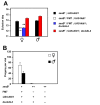Phenotypic rescue of a Drosophila model of mitochondrial ANT1 disease
- PMID: 24812436
- PMCID: PMC4036471
- DOI: 10.1242/dmm.016527
Phenotypic rescue of a Drosophila model of mitochondrial ANT1 disease
Abstract
A point mutation in the Drosophila gene that codes for the major adult isoform of adenine nuclear translocase (ANT) represents a model for human diseases that are associated with ANT insufficiency [stress-sensitive B(1) (sesB(1))]. We characterized the organismal, bioenergetic and molecular phenotype of sesB(1) flies then tested strategies to compensate the mutant phenotype. In addition to developmental delay and mechanical-stress-induced seizures, sesB(1) flies have an impaired response to sound, defective male courtship, female sterility and curtailed lifespan. These phenotypes, excluding the latter two, are shared with the mitoribosomal protein S12 mutant, tko(25t). Mitochondria from sesB(1) adults showed a decreased respiratory control ratio and downregulation of cytochrome oxidase. sesB(1) adults exhibited ATP depletion, lactate accumulation and changes in gene expression that were consistent with a metabolic shift towards glycolysis, characterized by activation of lactate dehydrogenase and anaplerotic pathways. Females also showed downregulation of many genes that are required for oogenesis, and their eggs, although fertilized, failed to develop to the larval stages. The sesB(1) phenotypes of developmental delay and mechanical-stress-induced seizures were alleviated by an altered mitochondrial DNA background. Female sterility was substantially rescued by somatic expression of alternative oxidase (AOX) from the sea squirt Ciona intestinalis, whereas AOX did not alleviate developmental delay. Our findings illustrate the potential of different therapeutic strategies for ANT-linked diseases, based on alleviating metabolic stress.
Keywords: Adenine nucleotide translocase; Alternative oxidase; Mitochondrial biogenesis; Mitochondrial disease.
© 2014. Published by The Company of Biologists Ltd.
Figures






Similar articles
-
The alternative oxidase AOX does not rescue the phenotype of tko25t mutant flies.G3 (Bethesda). 2014 Aug 21;4(10):2013-21. doi: 10.1534/g3.114.013946. G3 (Bethesda). 2014. PMID: 25147191 Free PMC article.
-
Gene expression in a Drosophila model of mitochondrial disease.PLoS One. 2010 Jan 6;5(1):e8549. doi: 10.1371/journal.pone.0008549. PLoS One. 2010. PMID: 20066047 Free PMC article.
-
A temperature-sensitive allele of Drosophila sesB reveals acute functions for the mitochondrial adenine nucleotide translocase in synaptic transmission and dynamin regulation.Genetics. 2003 Nov;165(3):1243-53. doi: 10.1093/genetics/165.3.1243. Genetics. 2003. PMID: 14668379 Free PMC article.
-
The adenine nucleotide translocase type 1 (ANT1): a new factor in mitochondrial disease.IUBMB Life. 2005 Sep;57(9):607-14. doi: 10.1080/15216540500217735. IUBMB Life. 2005. PMID: 16203679 Review.
-
Mitochondrial disease in flies.Biochim Biophys Acta. 2004 Dec 6;1659(2-3):190-6. doi: 10.1016/j.bbabio.2004.07.004. Biochim Biophys Acta. 2004. PMID: 15576051 Review.
Cited by
-
Updated Understanding of the Degenerative Disc Diseases - Causes Versus Effects - Treatments, Studies and Hypothesis.Curr Genomics. 2020 Sep;21(6):464-477. doi: 10.2174/1389202921999200407082315. Curr Genomics. 2020. PMID: 33093808 Free PMC article. Review.
-
A Drosophila model for mito-nuclear diseases generated by an incompatible interaction between tRNA and tRNA synthetase.Dis Model Mech. 2015 Aug 1;8(8):843-54. doi: 10.1242/dmm.019323. Epub 2015 May 5. Dis Model Mech. 2015. PMID: 26035388 Free PMC article.
-
Drosophila melanogaster Mitochondrial Carriers: Similarities and Differences with the Human Carriers.Int J Mol Sci. 2020 Aug 22;21(17):6052. doi: 10.3390/ijms21176052. Int J Mol Sci. 2020. PMID: 32842667 Free PMC article. Review.
-
The alternative oxidase AOX does not rescue the phenotype of tko25t mutant flies.G3 (Bethesda). 2014 Aug 21;4(10):2013-21. doi: 10.1534/g3.114.013946. G3 (Bethesda). 2014. PMID: 25147191 Free PMC article.
-
Increased levels of mitochondrial import factor Mia40 prevent the aggregation of polyQ proteins in the cytosol.EMBO J. 2021 Aug 16;40(16):e107913. doi: 10.15252/embj.2021107913. Epub 2021 Jun 30. EMBO J. 2021. PMID: 34191328 Free PMC article.
References
-
- Barca E., Aguennouz M., Mazzeo A., Messina S., Toscano A., Vita G. L., Portaro S., Parisi D., Rodolico C. (2013). ANT1 is reduced in sporadic inclusion body myositis. Neurol. Sci. 34, 217–224 - PubMed
-
- Bradford M. M. (1976). A rapid and sensitive method for the quantitation of microgram quantities of protein utilizing the principle of protein-dye binding. Anal. Biochem. 72, 248–254 - PubMed
-
- Chaturvedi R. K., Beal M. F. (2013). Mitochondria targeted therapeutic approaches in Parkinson’s and Huntington’s diseases. Mol. Cell. Neurosci. 55, 101–114 - PubMed
Publication types
MeSH terms
Substances
LinkOut - more resources
Full Text Sources
Other Literature Sources
Medical
Molecular Biology Databases

